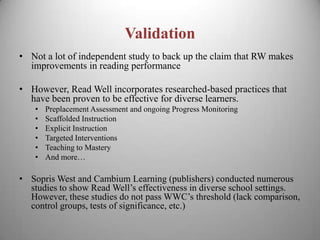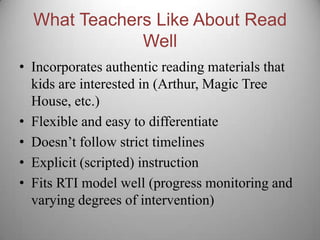Read well presentation
- 1. âĒRead Well is a primary reading curriculum that adjusts to the needs of each student. âĒK-2+ reading core and intervention programs âĒ Mastery-based and research-validated instructional strategies. âĒMultiple entry points for placement into appropriate small groups. âĒA unique sound sequence. âĒDifferentiated instruction with flexible pacing. âĒOngoing assessment and progress monitoring. âĒAn instructional framework that addresses the needs of a response to intervention (RtI) model.
- 2. What is Read Well? Read Well is a research-based primary reading curriculum that consists of whole class and small group instruction and independent practice. Students are placed into small groups based on assessed skills and should acquire mastery before moving on.
- 3. Placement
- 5. Published by SOPRIS WEST Education Services COST âĒ Instructor Package RWK -- $1,298.00 âĒ Student Package -- $2,158.00 (for 24 students) âĒ Instructor Package RW1 -- $1,082.00 âĒ Student Package RW1 -- $2,275.00 âĒ Instructor Package RW2 -- $1,136.00 âĒ Student Package RW2 -- $2,273.00
- 6. All Read Well Products Can Be Purchased @ http://www.voyagerlearning.com/readwell/index.jsp
- 7. Designed to meet the needs ofâĶ âĒ Whole Group âĒ Small Group âĒ Individual Assessment and Practice
- 8. Age appropriate whole Explicit Instruction Small group class instruction placement Ongoing Assessment determined by assessed skill level Targeted extra practice and reinforcement Skills taught to mastery in small group lessons.
- 9. What makes Read Well different? What makes it work? âĒ Designed to be flexible to meet the needs of all students, regardless of their ability or achievement level âĒ Small group placement determined by assessed skill level (ORF) âĒ Skills taught to mastery in small-group instruction, with sufficient, targeted, appropriate extra practice to reinforce skills as needed âĒ Ongoing assessment to monitor progress and guide pacing âĒ Daily instruction in phonemic awareness, phonics, vocabulary, comprehension and fluency âĒ Comprehensive and ongoing professional development
- 10. Implementation Scheduling options for 120 min/90 min/60 min (and what is covered during this time) 120 minutes: 30 minutes whole class [Read Well ABC Routines, Theme- Related Read Alouds, and Write Well Spelling] and 30 minutes small groups (3) [Classroom teacher with 3 group rotations: 30 mins Teacher- Directed instruction, 30 mins Read Well Independent Work, 30 mins Teacher-Developed Center Activites] 90 minutes: 60 minute walk-to-read (Teacher and Assistant 45 minutes directed; 15 minute independent work); plus 30 minute whole-class instruction (Teacher doing Read Well ABC Routines, Theme-Related Read Alouds, and Write Well Spelling) 60 minutes: walk-to-read with Teacher and no whole-class instruction
- 11. Whole Group Warm-up (Alphabet Cheers, ABC routines) Review or Preview decoding, choral reading, repeated reading, themed read alouds Write Well Spelling
- 12. Small Group Teacher Directed: Sound Reviews, Exercises, Vocabulary and Story Reading Independent: Story Rereading, Comprehension and Skill Activities
- 13. Validation âĒ Not a lot of independent study to back up the claim that RW makes improvements in reading performance âĒ However, Read Well incorporates researched-based practices that have been proven to be effective for diverse learners. âĒ Preplacement Assessment and ongoing Progress Monitoring âĒ Scaffolded Instruction âĒ Explicit Instruction âĒ Targeted Interventions âĒ Teaching to Mastery âĒ And moreâĶ âĒ Sopris West and Cambium Learning (publishers) conducted numerous studies to show Read Wellâs effectiveness in diverse school settings. However, these studies do not pass WWCâs threshold (lack comparison, control groups, tests of significance, etc.)
- 14. Validation
- 15. IES What Works Clearinghouse Effectiveness Read WellÂŪ was found to have no discernible effects on reading achievement and potentially positive effects on English language development for elementary school English language learners.
- 16. What Teachers Like About Read Well âĒ Incorporates authentic reading materials that kids are interested in (Arthur, Magic Tree House, etc.) âĒ Flexible and easy to differentiate âĒ Doesnât follow strict timelines âĒ Explicit (scripted) instruction âĒ Fits RTI model well (progress monitoring and varying degrees of intervention)
- 17. Sources Cited Cambium Learning Group/Voyager www.voyagerlearning.com/readwell Lisa Elliot, Wildwood Park Elementary. http://www.slideshare.net/LisaDElliott/read-well What Works Clearinghouse http://ies.ed.gov/ncee/wwc/interventionreport.aspx?sid=411

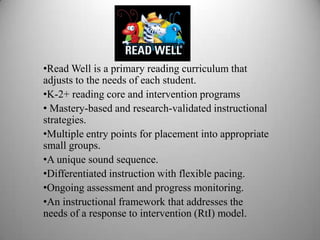
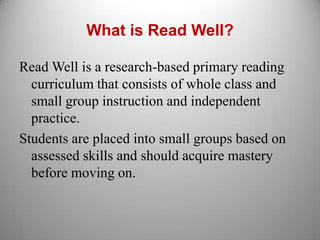
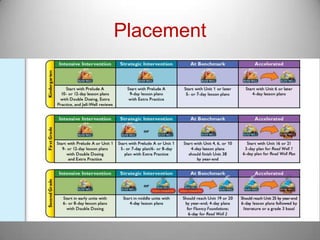






![Implementation
Scheduling options for 120 min/90 min/60 min
(and what is covered during this time)
120 minutes: 30 minutes whole class [Read Well ABC Routines, Theme-
Related Read Alouds, and Write Well Spelling] and 30 minutes small
groups (3) [Classroom teacher with 3 group rotations: 30 mins Teacher-
Directed instruction, 30 mins Read Well Independent Work, 30 mins
Teacher-Developed Center Activites]
90 minutes: 60 minute walk-to-read (Teacher and Assistant 45 minutes
directed; 15 minute independent work); plus 30 minute whole-class
instruction (Teacher doing Read Well ABC Routines, Theme-Related Read
Alouds, and Write Well Spelling)
60 minutes: walk-to-read with Teacher and no whole-class instruction](https://image.slidesharecdn.com/readwellpresentation-111104071745-phpapp02/85/Read-well-presentation-10-320.jpg)


